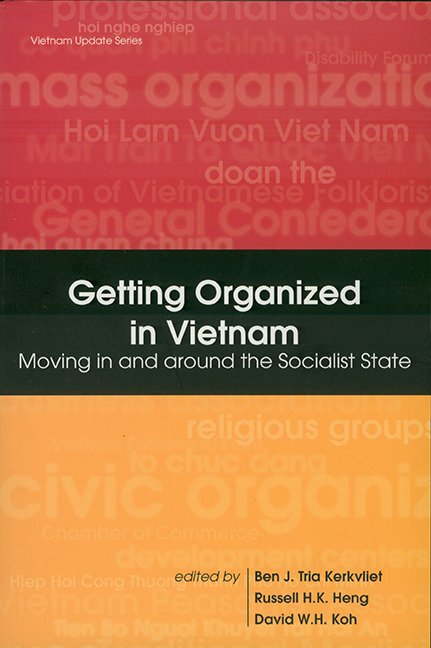Book contents
- Frontmatter
- Contents
- Preface
- Abbreviations
- Introduction: Grappling with Organizations and the State in Contemporary Vietnam
- 1 From Fence-Breaking to Networking: Interests, Popular Organizations, and Policy Influences in Post-Socialist Vietnam
- 2 Business Associations and Policy-Making in Vietnam
- 3 NGOs and Highland Development: A Case Study in Crafting New Roles
- 4 The Disabled and Their Organizations: The Emergence of New Paradigms
- 5 Authoritarian Governance and Labour: The VGCL and the Party-State in Economic Renovation
- 6 The Relationship between Civic and Governmental Organizations in Vietnam: Selected Findings
- 7 Donors, Local Development Groups and Institutional Reform over Vietnam's Development Decade
- Index
- About the Contributors
4 - The Disabled and Their Organizations: The Emergence of New Paradigms
Published online by Cambridge University Press: 21 October 2015
- Frontmatter
- Contents
- Preface
- Abbreviations
- Introduction: Grappling with Organizations and the State in Contemporary Vietnam
- 1 From Fence-Breaking to Networking: Interests, Popular Organizations, and Policy Influences in Post-Socialist Vietnam
- 2 Business Associations and Policy-Making in Vietnam
- 3 NGOs and Highland Development: A Case Study in Crafting New Roles
- 4 The Disabled and Their Organizations: The Emergence of New Paradigms
- 5 Authoritarian Governance and Labour: The VGCL and the Party-State in Economic Renovation
- 6 The Relationship between Civic and Governmental Organizations in Vietnam: Selected Findings
- 7 Donors, Local Development Groups and Institutional Reform over Vietnam's Development Decade
- Index
- About the Contributors
Summary
Given Vietnam's war-torn history, the disabled form a sizeable community. Organized treatment of the disabled was largely in state hands until the 1980s when political reforms enabled a bigger, more proactive role for citizens to organize their own affairs. Part of this self-organization meant contact and interaction with the outside world and the input of foreign ideas and financial resources that in turn challenged the old state-dominant policy, both in terms of assumptions and in practice. In effect, there have been paradigm shifts in governance where the management of the disabled is concerned. This study looks at one such organization that grew up in a time of paradigm shifts. The details provided describe the dynamics of how NGOs relate to the state.
This paper is a study on the situation of disabled people in Vietnam that goes beyond the statistics on various kinds of disabilities and their health or rehabilitation related aspects. Some developments in the disability scene over the past two years justify the author's choice of the present subject for discussion in the context of governance. The point of departure has been the author's first-hand knowledge of a self-help group of disabled people in Hoi An, Central Vietnam, acquired during his stay there between December 1999 and July 2000. Another starting point was the author's friendship with the group's leading member, Le Nguyen Binh, and the latter's involvement with a website created for the Disability Forum, a group of foreign NGOs focusing on people with disabilities in Vietnam. Beyond this, the data is based on on-line resources and e-mail communication. The interviews targeting the Hoi An group, conducted largely by e-mail, followed the ethnographic method of M.H. Agar (Agar 1980). Most documents and data were collected from February through October 2001, without any opportunity for fieldwork. Some of the conclusions in this chapter were checked on the ground during the author's brief visit to Hanoi in December 2001.
- Type
- Chapter
- Information
- Getting Organized in VietnamMoving in and around the Socialist State, pp. 126 - 152Publisher: ISEAS–Yusof Ishak InstitutePrint publication year: 2003

